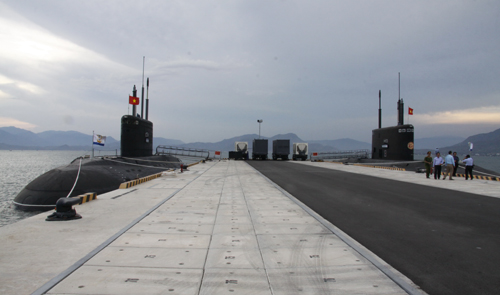Incumbent and former officials of Ho Chi Minh City have recently paid a ritual visit to one of two Russian-made Kilo-class submarines stationed at Cam Ranh base in the central province of Khanh Hoa.
The submarine is named HQ-183 TP. Ho Chi Minh, after Ho Chi Minh City, and now operated by Submarine Brigade 189 alongside the other, HQ-182 Hanoi.
The ships are the first two of six diesel-electric submarines Vietnam contracted to buy from Russia in 2009.
The subs are built for extended combat range and are able to strike land, surface, and underwater targets, including anti-shipping and anti-submarine operations in relatively shallow waters thanks to advanced stealth technology.
The pride
Seasoned naval ship sailors joined a delegation from Ho Chi Minh City to visit HQ-183 TP. Ho Chi Minh at Cam Ranh on Sunday, and were both eager and proud to see the submarine, which is dubbed the ‘black hole in the ocean’ as it is extremely silent during operation.
The delegation, led by HCMC Party Secretary Le Thanh Hai, was made up of the city People’s Committee chairman Le Hoang Quan, former State President Nguyen Minh Triet, who is also a former HCMC Party Secretary, and around a dozen other officials.
After setting foot in the hull of the HQ-183 TP.HCM submarine, former President Triet gave flags, campaign medals, and gifts to the naval soldiers of brigade 189.
Triet encouraged them to be alert while training and working to actively defend the national sovereignty of Vietnam.
“Occurrences in the region and the world are complicated and so you must be ready to fight to protect the nation,” he told the naval soldiers.
HCMC Party Secretary Le Thanh Hai said he was proud to see one of the submarines named after Ho Chi Minh City, and stressed that submarine soldiers had to always remember to be “faithful, disciplined, seasoned, and safe.”
Senior Lieutenant Colonel Tran Thanh Nghiem, head of Fleet 189, also spoke to the delegation about the submarines. Inside the first compartment of the ship are yellow tubes for launching torpedoes and a computerized control system. Behind the tubes is an automatic torpedo feeding system.
Senior Lieutenant Bui Trung Kien, 33, is the officer in charge of fire power commands, nicknamed a ‘trigger puller.’
However, he refused the nickname, insisting that submarine combat relies on collective strength.
With a weather-beaten complexion, Kien said that he had spent a long-term training session in Russia and made a voyage with the submarine at the depth of 300m in Russian sea waters.
Senior lieutenant Le Ba Tinh, 33, who is in charge of the torpedo, said he had trained in Russia for 19 months before returning to Vietnam.
Russian trainers always enjoyed working with and respected their Vietnamese students, thanks to their work ethic and high comprehension, Tinh said.
Vice chief Nguyen Tien Doat took the delegation to visit his command compartment, which includes electronic monitors, an observation system, and the main control system.
Admiral Nguyen Van Hien confirmed that his sailors are always ready to fight and to return any enemy attack.
Modern submarines
Vietnam’s kilo-class submarines can work in both shallow waters and areas with a maximum depth of 300m. Each sub, with a hull length of 73.8m and a beam of 9.9m, has a speed of 12kt (1kt is equal to one nautical mile per hour) at the surface and 19kt when submerged.
With a total crew of 52, the submarines can work constantly for 45 days at sea to patrol a distance of 7,500 nautical miles.
Its control system allows the tracking of many different targets simultaneously. The course, position, and speed data of the navigation system is also fed into the combat data system.
The Vietnamese subs have improved stealth features; the hull has multilayer anechoic rubber tiles to absorb active sonar waves to reduce and distort the return signal.
Thus, it reduces the range of detection by passive sonar. With Klub-S and 3M-54E1 missiles, Vietnam’s submarines are well built for offensive and defensive actions, helping to increase the nation’s undersea capabilities. They can assault cruisers and even aircraft carriers.






















































